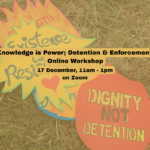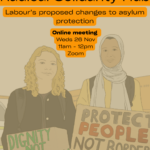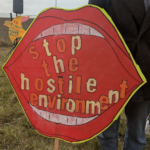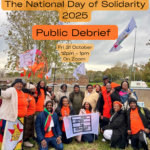
11 January 2023: for the latest update on the Rwanda legal case, read our latest Legal Update here.
21 December 2022: since this blog post was first published, we have drafted a new Toolkit page on the Inadmissibility Rules which you can access here.
Recent headlines have been flooded with news about the UK government’s inhumane Rwanda plan. All of this information can be quite confusing. In this blog we will try to break it down.
- What is the Rwanda offshoring plan?
- What are the inadmissibility rules?
- The link between the inadmissibility rules and Rwanda plan
- Why are the court cases to stop the Rwanda plan continuing if the flight in June was stopped from taking off?
- Why is there another court hearing in September?
Read on to find out the answers to these questions and more.
Update (21 December 2022): since this blog post was first published, we have drafted a new Toolkit page on the Inadmissibility Rules which you can access here.
What is the Rwanda offshoring plan?
In April 2022, the government announced plans to forcibly send certain categories of people seeking asylum to Rwanda. Instead of having their applications assessed in Britain, the process will be managed by the Rwandan government. If successful, and granted refugee status, the person will be expected to live in Rwanda.
Who could be sent to Rwanda?
There’s a lot we don’t know yet about how the plan will operate, and legal challenges are ongoing (see below). Currently the guidance indicates that it will apply to adults without children whose claim is deemed as inadmissible (see below) and (a) their journey to the UK can be described as having been dangerous and (b) was made on or after 1 January 2022. A dangerous journey is one able or likely to cause harm or injury. For example, this would include those that travel in a small boat, or clandestinely in lorries.
What are the inadmissibility rules?
The inadmissibility rules were first introduced by the Home Office in January 2021 as a result of the UK leaving the European Union (EU). The Home Office is the UK government department that is responsible for immigration matters. You can read the most recent Home Office guidance on inadmissibility here.
Inadmissibility is defined as follows:
‘In broad terms, asylum claims may be declared inadmissible and not substantively considered in the UK, if the claimant was previously present in or had another connection to a safe third country, where they claimed protection, or could reasonably be expected to have done so, provided there is a reasonable prospect of removing them in a reasonable time to a safe third country.’
What this means:
If it is found that someone claiming asylum in Britain passed through a country on the way to the UK where they could have, or they did apply for asylum, and they can be fairly easily removed to another country that the UK government has an agreement with, then their asylum claim will not be looked at in Britain. A process will begin to try and remove them to another country, but not necessarily the country that they passed through
When the UK was a member of the EU, it took part in an agreement called the Dublin III Regulation with other EU countries. Under this agreement the UK was able to, under certain circumstances, return migrants to an EU country that they had passed through before arriving in the UK. This agreement no longer applies to the UK because the UK left the EU after Brexit, and the inadmissibility rules are meant to replace it.
The link between the inadmissibility rules and Rwanda plan
The issue is that because the UK no longer has agreements with EU states – the countries in Europe which migrants are more likely to have passed through on their way to the UK – the Home Office cannot return migrants to the safe third countries mentioned in the inadmissibility definition.
As a result, on 14 April 2022 the UK entered into an agreement with the Rwandan government to make arrangements to remove people seeking asylum who fulfilled the ‘inadmissibility’ definition (this means they had been present in or had a connection to a safe third country) to Rwanda as another ‘safe third country’ to have their asylum claim processed there.
The intention is that if a person’s asylum claim is accepted in Rwanda, they will be offered what the agreement between the two governments is calling ‘pathways to legal residence’ in Rwanda. This agreement between the UK and Rwandan governments is called the Migration and Economic Development Partnership (MEDP).
The Home Office states that the purpose of the inadmissibility rules and Rwanda plan is to ensure the safety of people seeking asylum and to limit the activity of human traffickers and criminal gangs.
‘The inadmissibility process is intended to support safety of asylum seekers, the integrity of the border and the fairness of the asylum system, by encouraging asylum seekers to claim protection in the first safe country they reach and deterring them from making unnecessary and dangerous onward journeys to the UK.’
This is far from the reality of relocating migrants to Rwanda. The real purpose is to stop people from claiming asylum in the UK. Rwanda is rarely going to be a country that migrants pass through on their way to the UK. For many people who the UK government intends to send there, it will be a place that they have never before visited.
Rwanda also has a poor human rights record and many senior officials, including the British High Commissioner to Rwanda, had warned the Home Office not to sign a deal with the country because of this.
Key points to note
There is still a lot we do not know about the Rwanda plan, because it is facing many legal challenges. Until the time of writing (3 August 2022), no one has been sent to Rwanda (discussed below).
Here are some key points from the Home Office guidance document:
- The terms ‘removal’ and ‘relocation’ to Rwanda are used interchangeably in the document.
- The plan will not apply to unaccompanied minor children (those under the age of 18).
- Right now, families with children under the age of 18 are not to be considered for removal to Rwanda on inadmissibility grounds, but this might change.
- A person claiming asylum may be eligible for removal to Rwanda if their claim is inadmissible and (a) their journey to the UK can be described as having been dangerous and (b) was made on or after 1 January 2022. A dangerous journey is one able or likely to cause harm or injury. For example, this would include those that travel in a small boat, or clandestinely in lorries. The Home Office says that the purpose of this is to reduce the amount of time spent in detention.
- People who the Home Office will consider for relocation to Rwanda can be detained or non-detained.
- Priority for relocation to Rwanda will be given to those who arrived in the UK after 9 May 2022.
- Anyone who is considered for relocation to Rwanda will have this confirmed in a Notice of Intent document.
The legal challenges so far
When the Home Office announced in April 2022 that the first flight to Rwanda would take off on 14 June, many organisations sprung into action to challenge the legality of this decision.
We have put together a timeline and explanation of the key events that have happened so far, and what is expected to happen next.
14 April 2022: The Home Office announced the Migration and Economic Development Partnership (MEDP) between the UK and Rwandan governments. The UK government paid £120 million to the Rwandan government for this agreement to take place. The first chartered (this means privately hired) flight to Rwanda was intended to take off on 14 June 2022. Over 100 people in immigration detention received Notices of Intent stating that they were being considered for removal.
April 2022: A pre-action letter was sent to the Home Secretary Priti Patel by legal representatives for Detention Action, Care4Calais and the Public and Commercial Services Union (PCS) – who represent Home Office Border Force staff – to challenge the legality of the Rwanda plan.
The pre-action letter demanded that the Home Office clearly define and publish the Rwanda plan – before the first flight was to take off – for the sake of the people directly affected by it, the Home Office staff members who would have to carry it out, and the British public at large.
Individual claims (this means separate cases) were also brought by lawyers of people who had been selected to board the first flight.
End of May 2022: The first person of those who were set to be relocated to Rwanda was released from detention. 99 people were still scheduled to get on the 14 June flight.
The charity Asylum Aid wrote to the Home Office setting out their legal case against the Rwanda plan. Some of the main arguments against the plan were:
- That it is based on a blanket (this means broad) assessment of Rwanda as a ‘safe’ country, which goes against the government’s commitment to case-by-case decision-making;
- It involves such tight timeframes – only seven days for each asylum seeker to obtain legal advice and to present their case – that the process is inherently flawed and unfair;
- Gives rise to a real risk that individuals may be removed to Rwanda without having had effective access to legal advice and courts.
9 June 2022: Following the pre-action letter sent in April 2022, judicial review proceedings at the High Court were issued by the legal team representing Care4Calais, Detention Action and PCS to challenge the Home Office’s plan to relocate people seeking asylum to Rwanda. They claimed that the Rwanda plan and the removal of four specific individuals was unlawful for a number of reasons, including:
- The lack of legal authority of the Home Secretary Priti Patel to carry out the removals.
- The irrationality of Priti Patel’s conclusion that Rwanda is a safe third country.
- The lack of measures to protect asylum seekers removed to Rwanda from malaria.
- The lack of compliance with the Human Rights Act 1998.
The UN High Commissioner for Human Rights (UNHCR) intervened (this means took part in the case as an extra party) in the case. In their analysis of the Rwanda plan, UNHCR stated that the plan was unlawful and that in carrying it out, the UK would not be fulfilling its legal obligations as a State that has signed the Refugee Convention and that receives asylum seekers seeking protection.
Separately, on the same day, Asylum Aid also made an application for an interim injunction (this means an urgent court-ordered action before a final judgement in a case) to stop the June 14 flight and any other flight from going to Rwanda until their application for judicial review of the plan as a whole was heard by the court. This application was supported by the charity Freedom from Torture.
At this point, the Home Office had refused to stop the first flight from taking off, even though the lawfulness of the Rwanda plan as a whole had not yet been decided by the UK courts and 30 people were still expected to be removed on the first flight on 14 June.
The claimants (this means the parties bringing the claim) were seeking ‘interim relief’ in the form of stopping the first flight from taking off. Interim relief is an action that can be applied for and granted by a judge, even before the final judgement in a case is made.
However, the High Court judge refused to block the 14 June flight to Rwanda. The judge said that there was a ‘material public interest’ in not stopping the flight, even before the lawfulness of the Rwanda plan as a whole was decided by a court. Permission was granted for the case to be appealed at the Court of Appeal on Monday 13 June, the day before the flight was set to take off.
13 June 2022: The Court of Appeal dismissed the appeal of the High Court’s decision, and gave the go-ahead for the flight to take off the next day.
At this stage, only seven people remained booked on the flight set to take off the following night.
The claimants applied for permission to appeal this decision at the Supreme Court.
Separately, Asylum Aid’s application for an injunction which was made on 9 June 2022 to stop the flight and any other flights to Rwanda before the judicial review hearing of the whole plan was dismissed by the High Court.
14 June 2022: The Supreme Court of the UK refused permission for the case to be appealed from the Court of Appeal.
In a final attempt to stop the flight from taking off that night, the legal team at Duncan Lewis Solicitors applied to the European Court of Human Rights (ECtHR) for an injunction to stop the removal of their client to Rwanda on the flight that night. The ECtHR is a body of the Council of Europe, which is a separate institution from the EU. As a member of the Council of Europe, the UK must comply with the ECtHR’s decisions. The ECtHR is based in Strasbourg, which is why you might sometimes see it being referred to as the ‘Strasbourg court’.
The ECtHR granted the injunction. The lawyers representing the last six individuals who were set to board the flight that night were then able to apply to the ECtHR for the injunction decision to be applied to their cases at the last minute as well; less than two hours before the flight was to take off.
In this way, the flight did not take off because no passengers were on-board.
11 July 2022: The hearing to decide whether or not the Rwanda plan as a whole is lawful which was set to be heard in July was adjourned (this means delayed) until the first week of September 2022.
19 July 2022: The High Court rejected the claimants’ request to have the hearing adjourned to later in the year, and set the timetable for the court dates for the hearing in September. A lot of work needs to be done by the legal teams to have evidence ready to submit by the deadlines set out by the court.
5 September 2022: This will be the first day of a 5-day hearing to decide on the lawfulness of the Rwanda plan.
Actions you can take – now and for our future
Many groups and individuals have been promoting petitions, hosting demonstrations and running other campaigns to stop the Rwanda plan, so keep an eye out for them and we encourage you to join them.
It’s also important to remember that the Rwanda plan is one of the many aspects of the Hostile Environment that our community of migrants, refugees, people seeking asylum and their families and friends is faced with. We need to come together and build a stronger movement of community resistance and protection for our future.
Now is the time to get involved. We have successfully delayed the Rwanda plan, and legal challenges are pending. But we need to keep organising to prevent “solutions” like this ever being on the table. We need to dismantle the Hostile Environment and build an alternative vision based on dignity, justice, solidarity and welcome.
Right to Remain is part of the Solidarity Knows No Borders network, a community of migrant organisations, groups and individuals, working in solidarity to end hostility and racism against migrants and refugees. As a community, we organise and strategise, share resources to build collective campaigns and actions. We show up in solidarity with each other; for both short term and long term change. Whether you are someone with lived experience of the immigration system, or someone who wants to take action in solidarity, this is the network for you. https://firmcharter.org.uk/
Want to learn more?
Have a read of this document drafted by Médecins Sans Frontières which debunks five ways in which the Home Office is trying to justify the Rwanda plan – it includes tips for how to write to your MP about this issue.














Discussion: